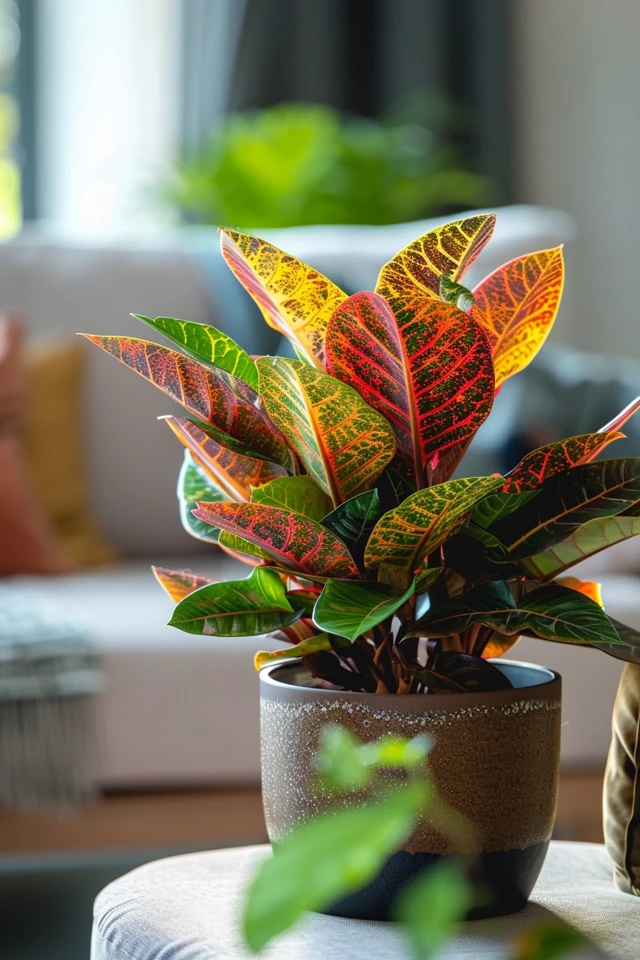Pruning a Croton plant is essential for its care and maintenance. Whether you want to control its height, shape it, or remove dead leaves, proper pruning techniques can help you achieve your desired results. In this guide, I will share some valuable tips on how to prune a Croton plant effectively.
Key Takeaways:
- Pruning a Croton plant helps maintain its health, shape, and appearance.
- Prune during the early spring, avoiding periods of active growth or cold snaps.
- Sanitize your pruning tools before and after each use to prevent the spread of diseases.
- Cut dead or damaged leaves just outside the main stem.
- Avoid cutting back the plant by more than one third to promote healthy growth.
- Pinch off new growth near the top of the plant to encourage bushier growth.
- Wear gloves when pruning to protect your hands from the plant’s sap.
When and How to Prune a Croton Plant
Pruning a Croton plant is an important aspect of its maintenance to ensure healthy growth and a desirable appearance. Learning the proper timing and techniques for pruning can make a significant difference in the plant’s overall health and vitality.
Crotons can be pruned at any time of the year, but it’s best to avoid pruning during periods of active growth or when a sudden drop in temperature is expected. Typically, early spring is the ideal time to prune most plants, including Crotons.
Before starting the pruning process, it’s crucial to sanitize your pruning tools. This step helps prevent the spread of diseases from one plant to another. A simple wipe-down with rubbing alcohol or a mixture of bleach and water can effectively disinfect the tools.

When trimming dead or damaged leaves, make clean cuts just outside the main stem. This technique promotes healthy growth and prevents any potential damage to the plant. Remember to wear gloves, as some Croton varieties produce a sticky sap that can cause skin irritation.
If you want your Croton to become bushier, strategically cut a foot above where you want new growth to emerge. This stimulates the plant to produce more branches, resulting in a denser appearance. However, avoid cutting more than one-third of the plant’s overall foliage, as it may cause stunted growth and stress the plant.
After pruning, provide your Croton with adequate water and nutrients to support its recovery and promote new growth. Ensure the plant receives sufficient sunlight and maintain a regular watering schedule to keep the soil moist but not waterlogged.
By following these Croton pruning techniques and taking proper care of your plant, you can enhance its health, shape, and overall beauty.

Additional Tips for Pruning Crotons
In addition to the general pruning techniques mentioned earlier, here are some additional tips to help you effectively prune your Croton plants.
Firstly, it’s crucial to sanitize your pruning tools before and after each use. This simple step helps prevent the spread of diseases and keeps your plants healthy. Cleaning the tools with a solution of one part bleach to nine parts water is a recommended practice.
When removing dead leaves or branches, make sure to cut them close to the main stem without causing any injury. This promotes healing and prevents any potential damage to the plant.
If you come across any swollen growths on the plant’s leaf veins or stems, it could be a sign of crown gall disease. In such cases, it’s best to cut off the galls with sanitized pruning tools immediately. Remember to discard the cuttings properly to avoid any further contamination.

Furthermore, if you encounter any diseased or unhealthy branches, it’s important to cut them at least six inches away from the affected area. This helps prevent the spread of infection to the rest of the plant.
If you want to encourage bushier growth, you can pinch off new growth near the top of the plant. This practice redirects the plant’s energy to the base, resulting in a fuller and more compact appearance.
Lastly, it’s advisable to wear gloves when pruning Crotons, as their sticky sap can cause skin irritation. Protecting your hands allows you to prune comfortably while minimizing the risk of any adverse reactions.
By following these additional tips, you can ensure that your Crotons thrive and maintain their beautiful appearance over time.

